In artist Maria Maea’s hands, the palm is much more than a plant — it’s a medium
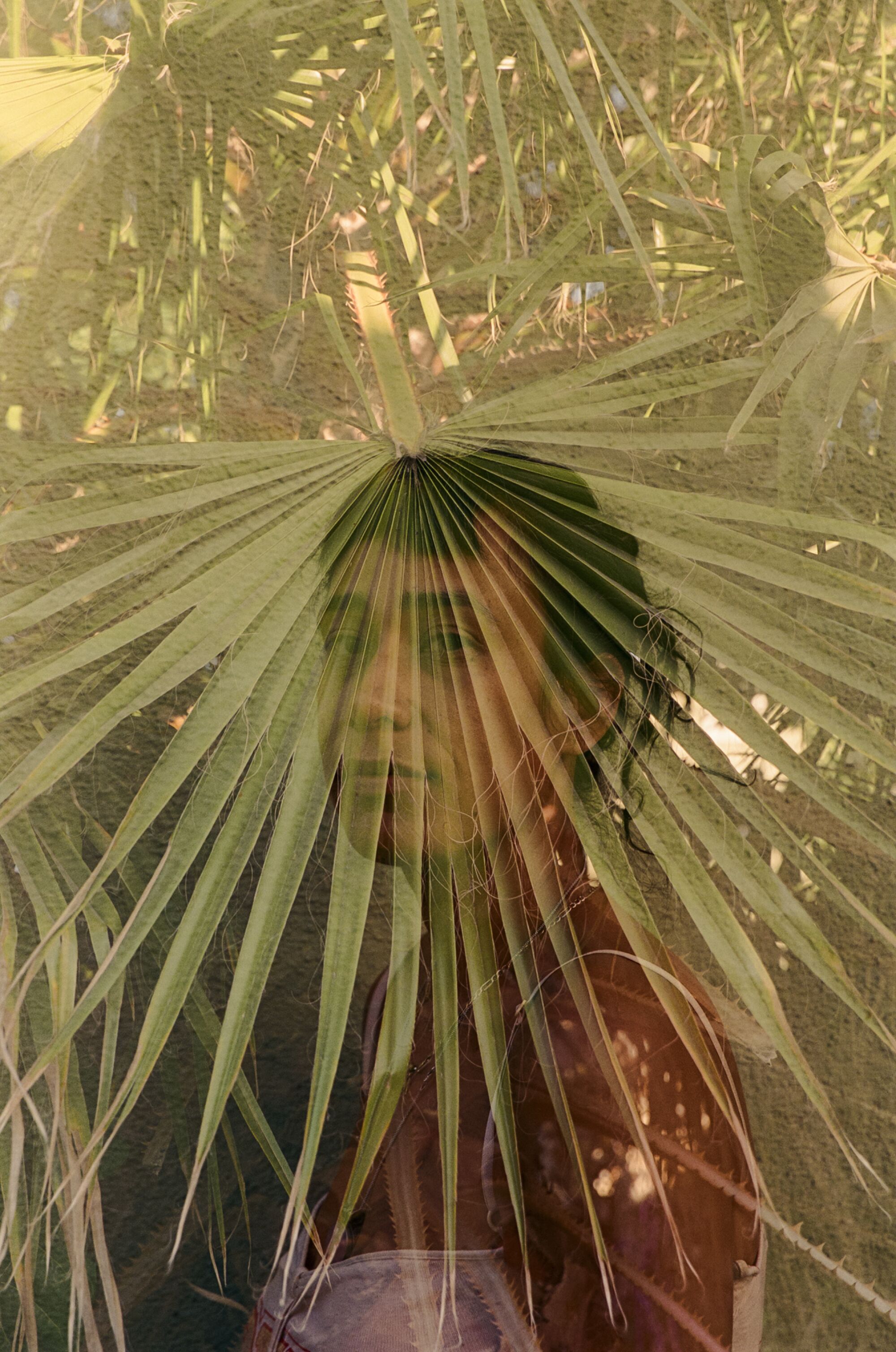
During the pandemic, artist Maria Maea began to think about the idea of “resource” and developed a relationship with the ubiquitous palm, using the process of weaving fronds into sculptures as a meditation unlocking ancestral memories.
(Samanta Helou Hernandez / For the Times)
It’s a sunny afternoon, right before golden hour, and multidisciplinary artist Maria Maea is surrounded by palm fronds growing in the corner of a nondescript parking lot in Echo Park. She grabs her curved knife and cuts a few leaves before moving on to another location. This has been a ritual of hers for nearly two years, using the ubiquitous palm as material for mixed-media sculptures made of wire, dried plants and, often, casts of her family and friend’s faces.
Pointing to the small palm tree, she notes that the palm is the same one she has in her backyard — albeit “it has grown so differently.”
That palm in her backyard started it all. Stepping into Maea’s backyard feels like being transported into her creative mind: Swiss chard, squash and mint grow in cracks of concrete, a fruit from a citrus tree falls next to a spiral staircase leading to nowhere, and a table decorated with seashells, a dried flower, photos and a mirror create a sort of altar, a collection of items, when inspiration is needed.
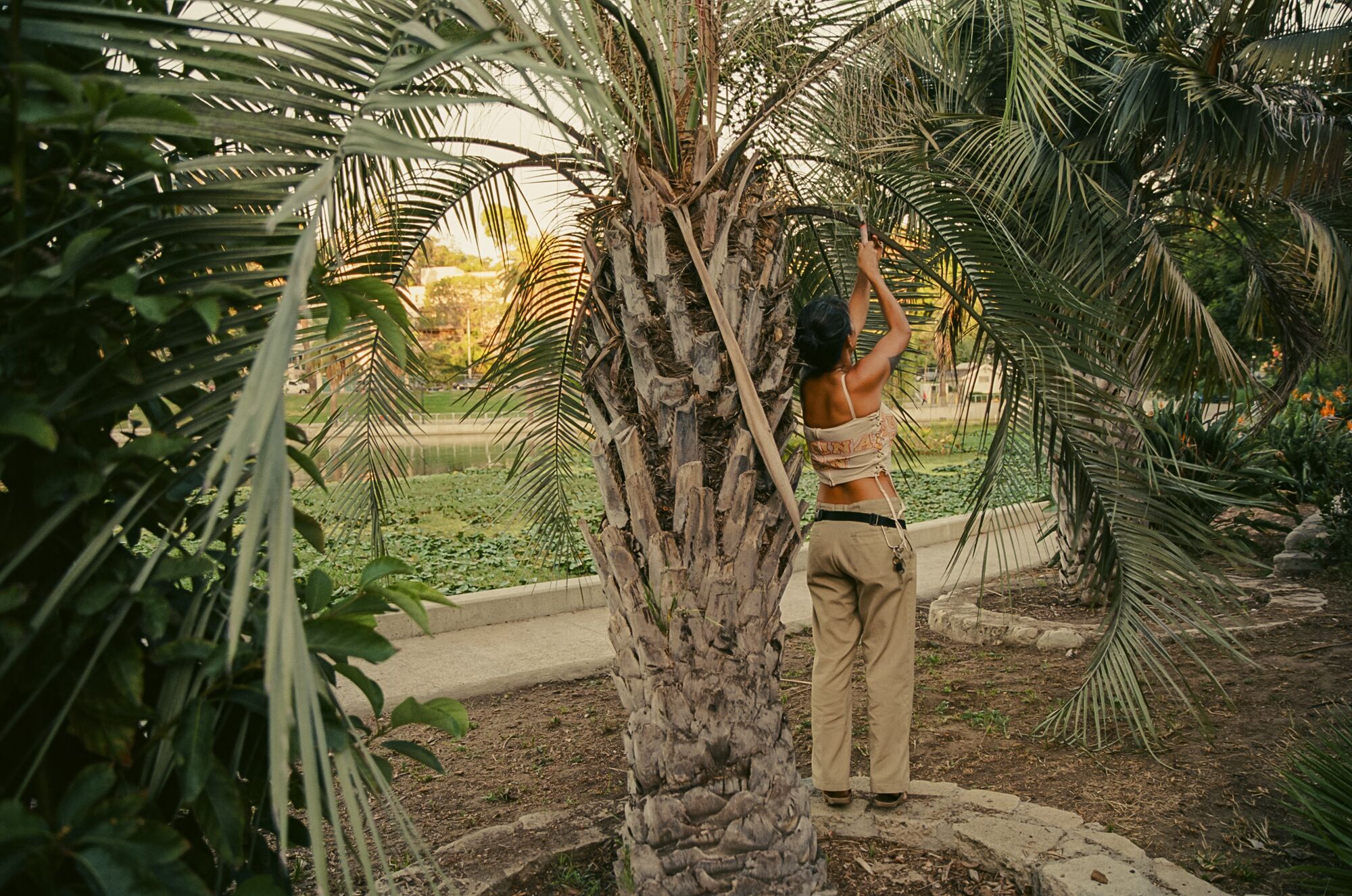
Maria Maea’s process entails taking walks in her neighborhood, sourcing palm fronds from nondescript parking lots, sidewalk cracks, and even Echo Park.
(Samanta Helou Hernandez / For the Times)
She points to a dried, towering sunflower that grew out of the concrete. In awe, Maea explains that she happened to sprinkle a seed into a crack, not expecting to be welcomed with a massive flower. For her first solo show at Murmurs Gallery, which opened Oct. 28 and runs until Dec. 17, the dried plant is used as a fishing pole held by a sculpture of her brother, a nod to her Samoan family member’s connection to fishing and working at canneries upon arriving in the U.S.
It’s clear, Maea’s greatest inspiration is nature itself. She has an ability to see plant matter’s potential to create new worlds. “Plants have a body, we mimic it, it mimics us,” explains Maea. “I’ll use corn as a spine and people recognize it because we’re mirrors of nature.”
During the pandemic Maea began a gardening practice, using the soil and land available to her to grow food. Through this process she started to think about resources and abundance.
One afternoon, as she sat looking at the palm in her yard, at the time just a baby tree, something clicked. “I wanted to see the environment as plentiful instead of scarce,” she says. “Palms are omnipresent, but invisible. They’re decorative, but we don’t really see them as plants.”
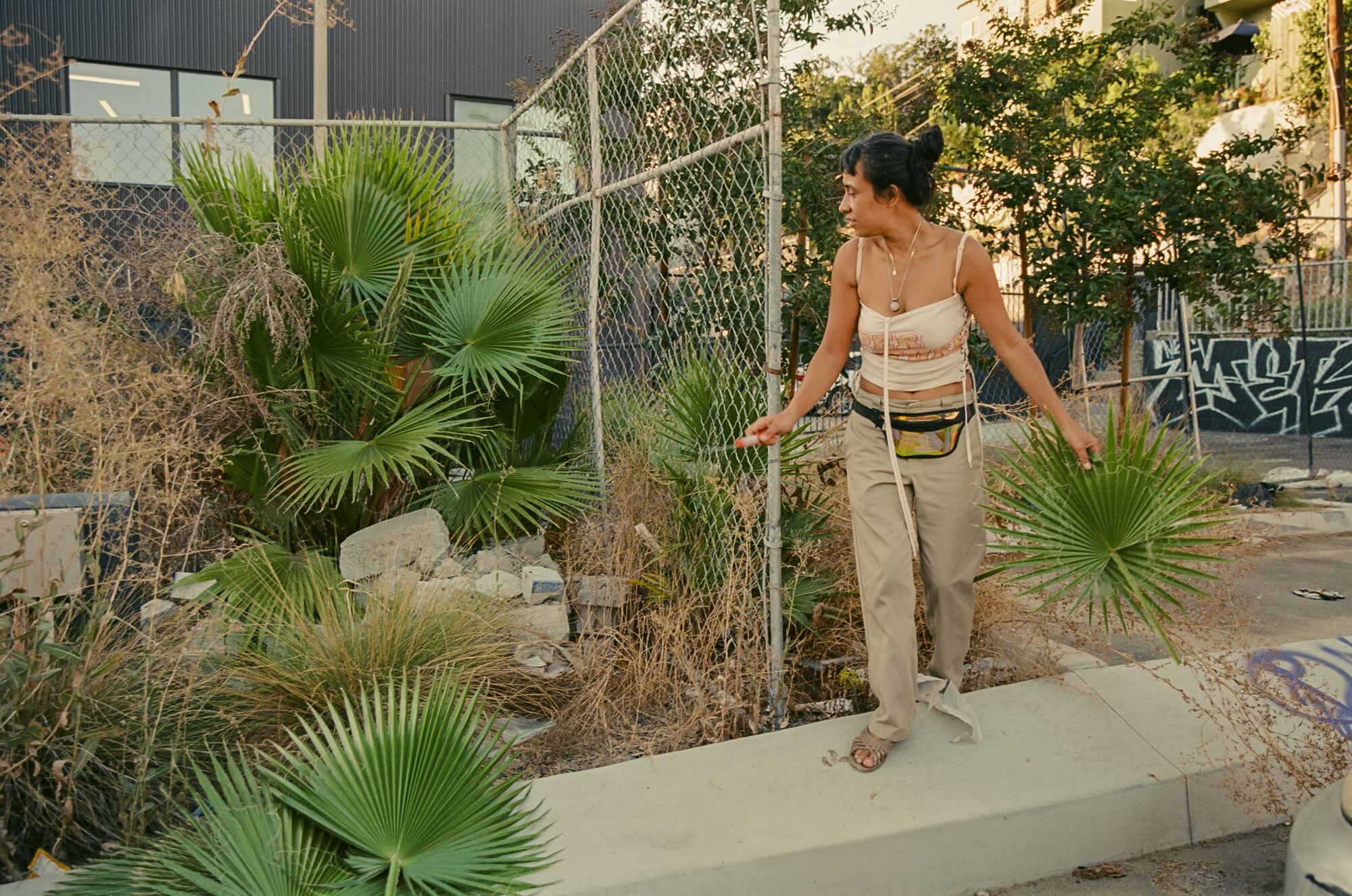
“I’ll see a palm growing in desolate areas and I feel like I have a relationship to a space automatically in a different way than I did before [working with palms],” she says. “I’ll be like, ‘How long have you been there? What’s your story?’”
(Samanta Helou Hernandez / For the Times)
The palm, a contentious signifier of L.A., is a ubiquitous, nonnative invasive species brought to the city decades ago to solidify the myth of Los Angeles as a “semi-tropic” paradise. For Maea, the complex identity of the palm felt like a mirror to her own identity growing up Samoan and Mexican in punk and DIY scenes in Long Beach. The palm inspired her to use this highly abundant, resilient, but often discarded element, and recontextualize it.
“I’ll see a palm growing in desolate areas, and I feel like I have a relationship to a space automatically in a different way than I did before [working with palms],” she says. “I’ll be like, ‘How long have you been there? What’s your story?’”
For the last two years, Maria has traversed the city gathering palms from Echo Park, the L.A. River and her native Long Beach. “The palm feels like a mapping tool, some of them are intentionally planted and some break through concrete of a parking lot. I can remember when I cut it. How I cut it,” she explains.
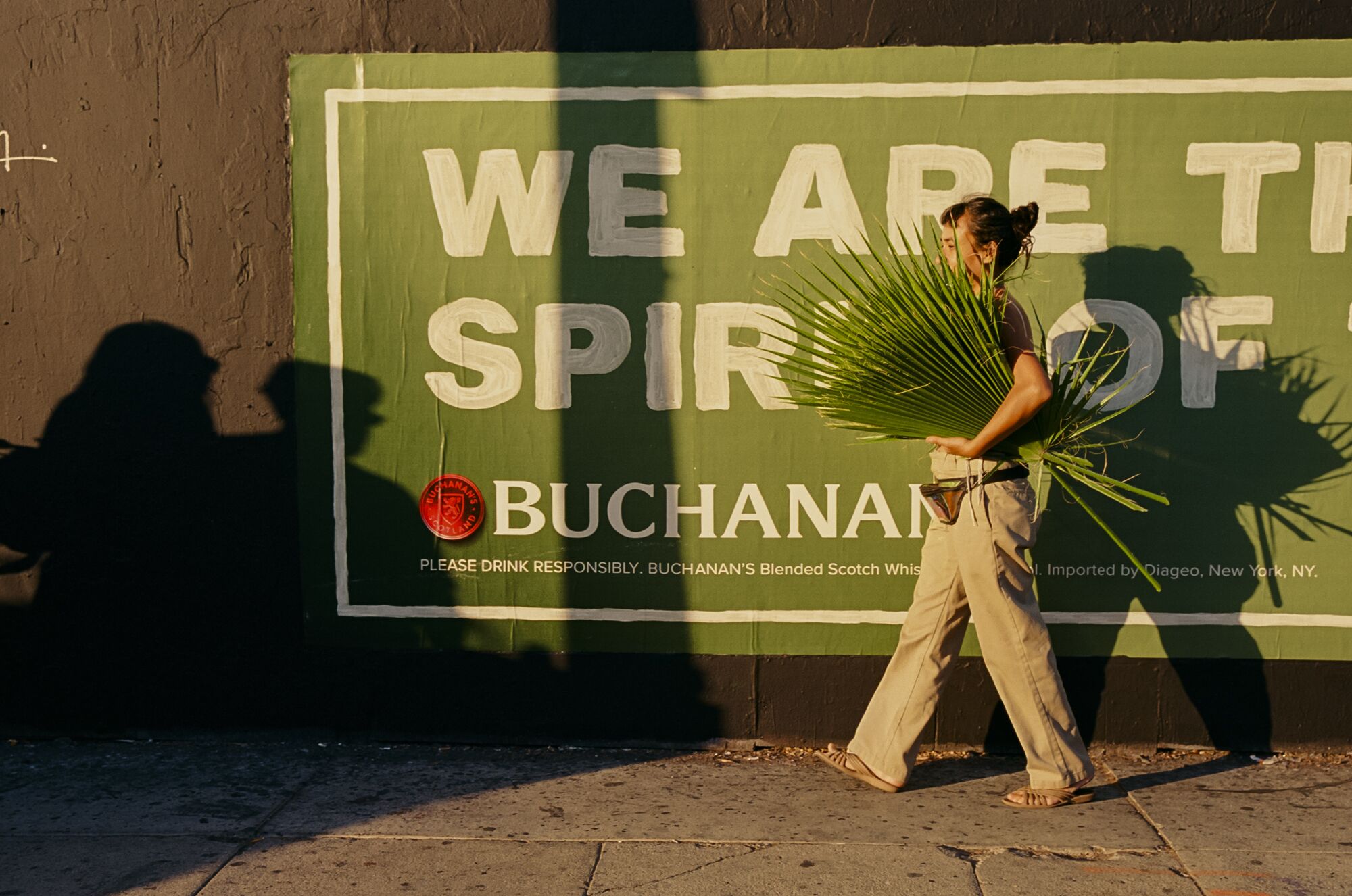
Maria Maea sources palms for her sculptures during golden hour in Echo Park.
(Samanta Helou Hernandez / For the Times)
Maea taught herself to weave the palm fronds using a Samoan technique. The repetitive act became a meditation. “What is this unlocking?” she asked herself. “I know my dad is from Jalisco and my mom is from Samoa, but our actual history has been kind of melted and molded by coming here. These practices are a way for the body to remember things the mind can’t comprehend.”
Eventually, as she geared up for her solo show, Maea brought her family in to help weave, making the effort communal. As patterns and sculptures emerged from the weaved objects, they became like quilts of the city and of her own family’s history.
On a hot September day in Long Beach, Maea’s mother, little sister, two brothers and aunt sat in the frontyard of her mother’s home with palms in hand. Some were cutting thorns off stems, others weaved. Her aunt, Sanita Tuufuli, took a palm and started weaving it, explaining in the process how in Samoa the weaved palm has a variety of uses: a fork, a spoon, a plate, a window to keep the rain out. As they weaved, the family cracked jokes, laughed and shared stories.
They did this together for three weeks, Wednesday through Friday, in preparation for the solo show. “I feel like my whole family is having an art show,” Maea says as she described the week of the opening.
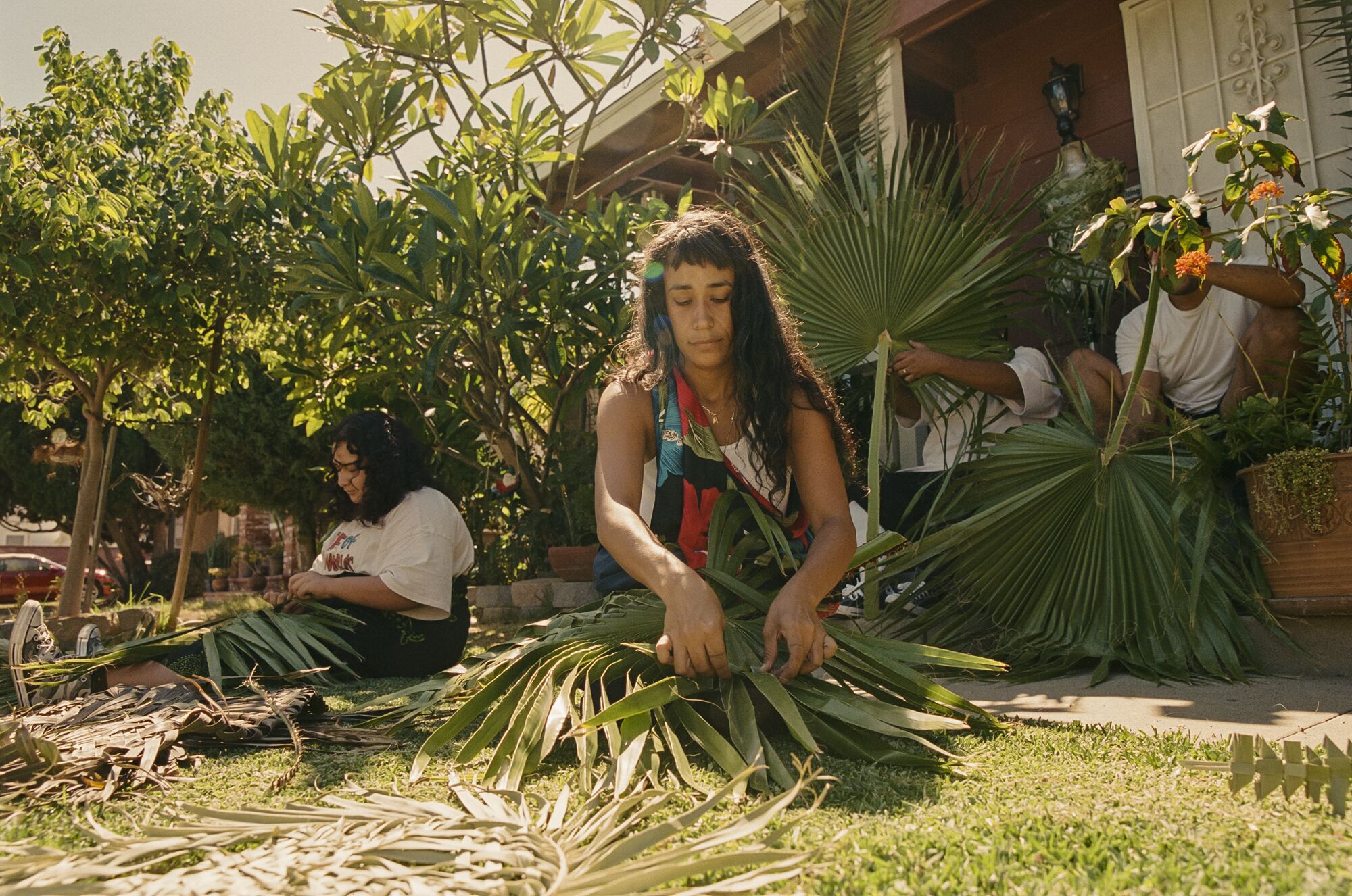
For three weeks, Maria Maea gathered with her family in Long Beach. Together, they cut and weaved palms in preparation for her first solo show at Murmurs Gallery. “I feel like my whole family is having an art show,” Maea says.
(Samanta Helou Hernandez / For the Times)
In many ways, the process is more important than the outcome for Maea. By gathering her family and creating art together, they’ve imbued memories and emotions into the objects themselves, they’ve bonded in new ways, and they’ve had an opportunity to showcase their creativity.
“I can remember the parts of the sculpture where I was pissed off at my boyfriend or talking to my mom,” she explains. “We’re gathering memories along the way, they all live in these weaves and these moments that are in some larger piece.”

Below: Maria Maea’s mother, Susan Tuilaepa, helped weave many of the sculptures in the show, including the centerpiece: a whirlpool made of palm fronds in which a sculpture of Tuilaepa emerges from. She also created a body made of weaved palm wearing a traditional Samonan head dress, which is displayed in its own room within the gallery.
(Samanta Helou Hernandez / For The Times)
The result is an allegory, a myth of her own making: a whirlpool made of palms in which a figure of Maea’s mother emerges from, her brother’s sculpture stands nearby separate from the swirl with the sunflower fishing rod, donning his signature Long Beach cap and Converse Chuck Taylors. Next to him, a cast of his son’s face encased in a jasmine bush that grew in Maea’s yard. In order to bring this sculpture into the gallery, the jasmine bush was displaced, therefore causing root shock, a metaphor of migration and diaspora.
“When I make these humanoid sculptures, I think of them as storytellers,” she explains. “I reuse my mom’s face over and over because it’s telling this story about who we are.”

Below: A sculpture of Maria Maea’s nephew covered in jasmine and milkweed vines lived in Maea’s backyard until she moved it to the gallery.
(Samanta Helou Hernandez / For The Times)
Maea’s sculptures have a fractured element to them, much like the fractured nature of memories.
Ultimately, this work, this process, asks us to think about how memory, whether ancestral, familial or cultural, functions. How does it bend, fracture, evolve overtime to serve our needs? How does it ultimately become a myth?

The complex identity of the palm in Los Angeles is both an inspiration and a mirror for Maria Maea.
(Samanta Helou Hernandez / For The Times)
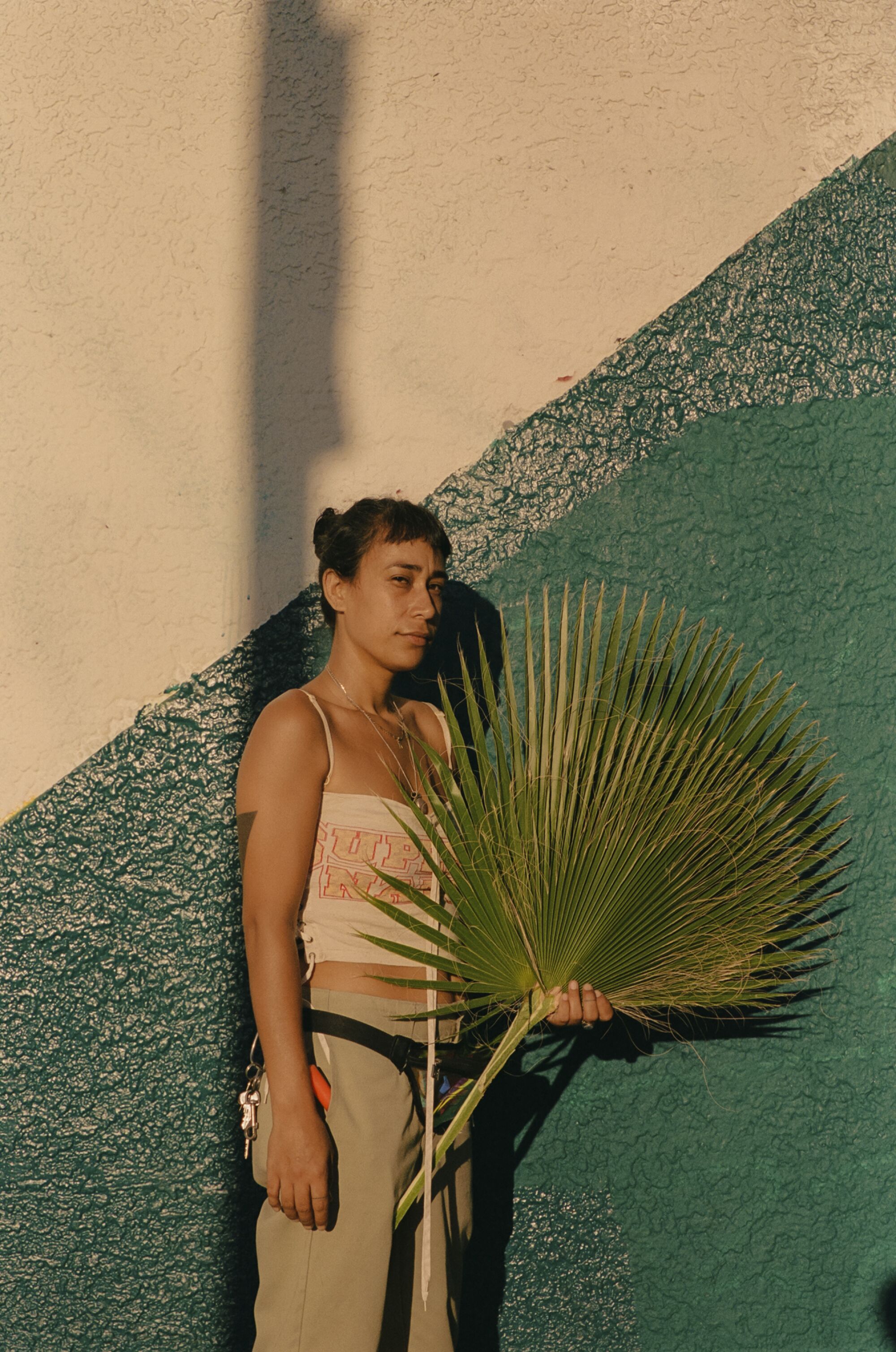
Maria Maea holds a palm, a medium she often uses in her work.
(Samanta Helou Hernandez / For The Times)

Above: What would eventually become a weaved whirlpool in the center of the gallery lays in the frontyard of Maria Maea’s family home in Long Beach. Maea’s own backyard, pictured below, is a reflection of her own creative mind, plant matter abounds, growing wildly, creating dreamscapes.
(Samanta Helou Hernandez / For The Times)

Above: Over several weeks, the sculpture of Maria Maea’s nephew, now in a new home, shed filaments and seeds, milkweed bugs roamed through the vines, and parts of the plant slowly died while others grew. Below: A whirlpool of palm fronds stands starkly in the center of Murmurs gallery, as a sculpture of Maria Maea’s mother emerges.
(Samanta Helou Hernandez / For The Times)
‘All in Time’
Where: Murmurs Gallery, 1411 Newton Street, Los Angeles
When: Tuesdays and Wednesdays, Fridays and Saturdays from 11-6PM. Closed Sundays, Mondays, and Thursdays.
Info: https://murmurs.la/
For all the latest Entertainment News Click Here
For the latest news and updates, follow us on Google News.
